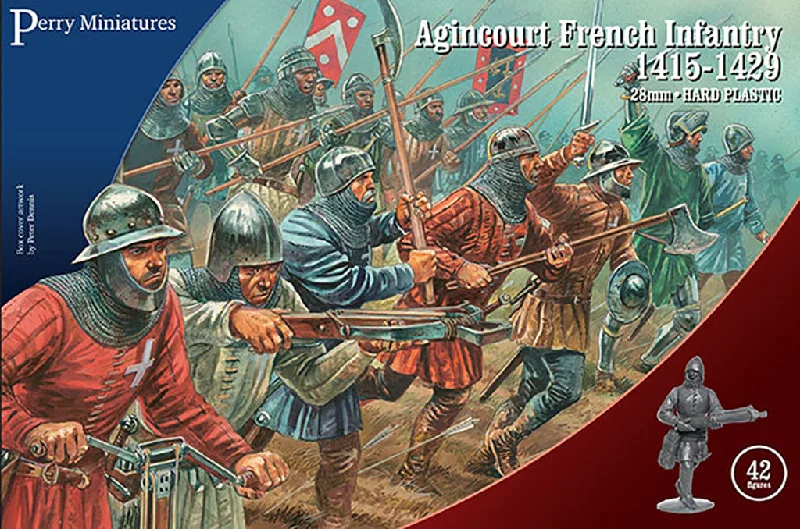- Scale: 28mm
- 42 Highly detailed plastic figures
- Unpainted figures, assembly with glue and painting required
- Molded in gray with green bases
- Recommended for 12 years and above
This is great addition to your diorama or miniatures gaming collection.
The Battle of Agincourt (French: Azincourt) was one of the greatest English victories in the Hundred Years' War. It took place on 25 October 1415 (Saint Crispin's Day) near Azincourt in the County of Saint-Pol, in northern France. England's unexpected victory against a numerically superior French army boosted English morale and prestige, crippled France, and started a new period in the war during which the English began enjoying great military successes.
After several decades of relative peace, the English had renewed their war effort in 1415 amid the failure of negotiations with the French. In the ensuing campaign, many soldiers died due to disease and the English numbers dwindled; they tried to withdraw to English-held Calais but found their path blocked by a considerably larger French army. Despite the disadvantage, the following battle ended in an overwhelming tactical victory for the English.
King Henry V of England led his troops into battle and participated in hand-to-hand fighting. King Charles VI of France did not command the French army himself, as he suffered from severe psychotic illnesses with moderate mental incapacitation. Instead, the French were commanded by Constable Charles d'Albret and various prominent French noblemen of the Armagnac party.
This battle is notable for the use of the English longbow in very large numbers, with the English and Welsh archers making up nearly 80 percent of Henry's army.
The French force was not only larger than that of the English, but their noble men-at-arms would have considered themselves superior to the large number of archers in the English army, whom the French (based on their experience in recent memory of using and facing archers) considered relatively insignificant. For example, the chronicler Edmond de Dyntner stated that there were "ten French nobles against one English", ignoring the archers completely. Several French accounts emphasize that the French leaders were so eager to defeat the English (and win the ransoms of the English men-at-arms) that they insisted on being in the first line; as one of the contemporary accounts put it: "All the lords wanted to be in the vanguard, against the opinion of the constable and the experienced knights."
The French were arrayed in three lines or "battles". The first line was led by Constable d'Albret, Marshal Boucicault, and the Dukes of Orléans and Bourbon, with attached cavalry wings under the Count of Vendôme and Sir Clignet de Brebant. The second line was commanded by the Dukes of Bar and Alençon and the Count of Nevers. The third line was under the Counts of Dammartin and Fauconberg. The Burgundian chronicler Jean de Wavrin said there were 8,000 men-at-arms, 4,000 archers and 1,500 crossbowmen in the vanguard, with two wings of 600 and 800 mounted men-at-arms, and a main battle comprising "as many knights, esquires and archers as in the vanguard", with the rearguard containing "all of the rest of the men-at-arms". The Herald of Berry gave figures of 4,800 men-at-arms in the first line, 3,000 men in the second line, with two "wings" containing 600 mounted men-at-arms each, and a total of "10,000 men-at-arms", but does not mention a third line.
Thousands of troops appear to have been in the rearguard, containing servants and commoners whom the French were either unable or unwilling to deploy. Wavrin gives the total French army size as 50,000: "They had plenty of archers and crossbowmen but nobody wanted to let them fire . The reason for this was that the site was so narrow that there was only enough room for the men-at-arms." A different source says that the French did not even deploy 4,000 of the best crossbowmen "on the pretext they had no need of their help

